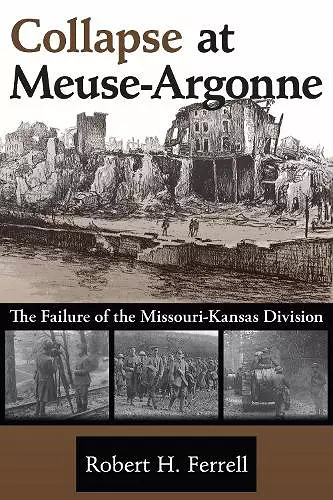Collapse at Meuse-Argonne
The Failure of the Missouri-Kansas Division
Format:Paperback
Publisher:University of Missouri Press
Published:30th Aug '17
Currently unavailable, and unfortunately no date known when it will be back

During World War I, the Thirty-fifth Division was made up of National Guard units from Missouri and Kansas. Composed of thousands of men from the two states, the Missouri-Kansas Division entered the great battle of the Meuse-Argonne with no battle experience and only a small amount of training, a few weeks of garrisoning in a quiet sector in Alsace. The division fell apart in five days, and the question Robert Ferrell attempts to answer is why.
The Thirty-fifth Division was based at Camp Doniphan on the Fort Sill reservation in Oklahoma and was trained essentially for stationary, or trench, warfare. In March 1918, the German army launched a series of offensives that nearly turned the tide on the Western Front. The tactics were those of open warfare, quick penetrations by massive forces, backed by heavy artillery and machine guns. The American Expeditionary Forces (AEF) commanded by Gen. John J. Pershing were unprepared for this change in tactics. When the Thirty-fifth Division was placed in the opening attack in the Meuse-Argonne on September 26, 1918, it quickly fell.
In addition to the Thirty-fifth Division’s lack of experience, its problems were compounded by the necessary confusions of turning National Guard units into a modern assemblage of men and machines. Although the U.S. Army utilized observers during the initial years of World War I, their dispatches had piled up in the War College offices in Washington and, unfortunately, were never studied.
The Thirty-fifth Division was also under the command of an incompetent major general and an incompetent artillery brigadier. The result was a debacle in five days, with the division line pushed backward and held only by the 110th Engineer Regiment of twelve hundred men, bolstered by what retreating men could be shoved into the line, some of them at gunpoint.
Although three divisions got into trouble at the outset of the Meuse-Argonne, the Thirty-fifth’s failure was the worst. After the collapse, the Red Cross representative of the division, Henry J. Allen, became governor of Kansas and instigated investigations by both houses of Congress. Secretary of War Newton D. Baker testified in an effort to limit the political damage. But the hullabaloo gradually died down, and the whole sad episode passed into the darker...
An excellent study of the interrelationship of leadership, training, morale, and unit cohesion. It offers the military professional a cautionary tale on how a unit composed of good soldiers can turn into a mob when they perceive their leaders are out of touch, indifferent, or too career-focused."" - Military Review
""This excellent book is what one expects from its author, unsurpassed for his industry, competence, and honesty. It is most unusual that a scholar of his eminence would devote himself to such a valuable “small” history. His father, a veteran of the AEF, would have been proud."" - Journal of Military History
ISBN: 9780826221421
Dimensions: unknown
Weight: 280g
176 pages